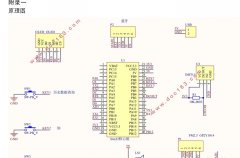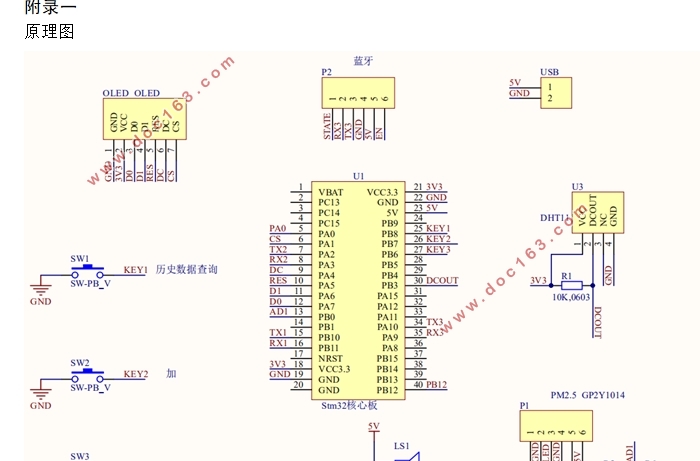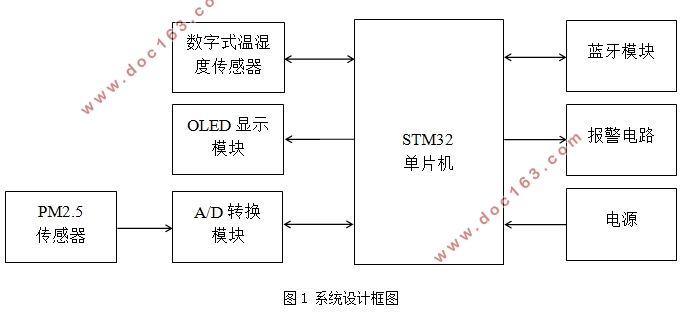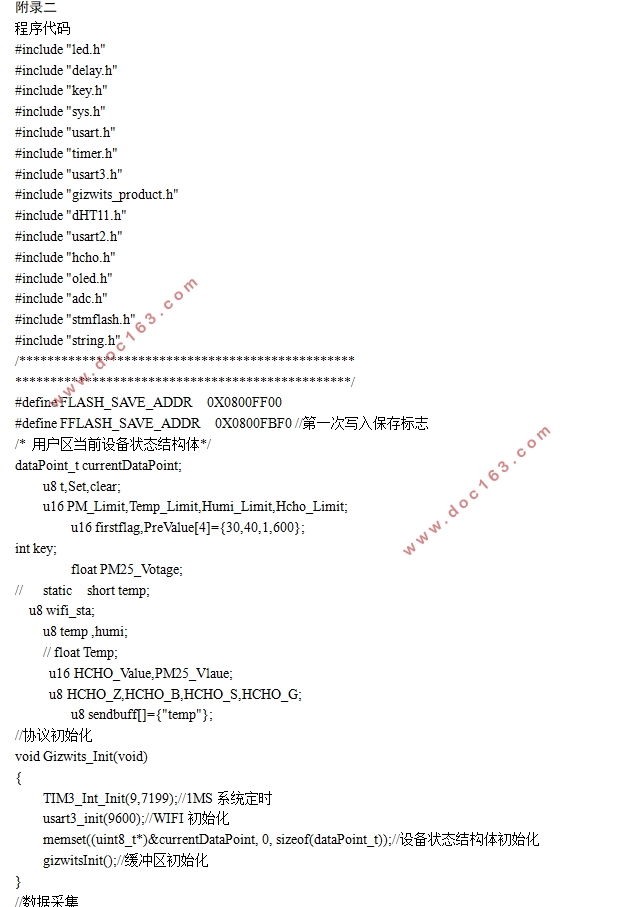基于STM32的便携式空气质量检测仪设计

1.无需注册登录,支付后按照提示操作即可获取该资料.
2.资料以网页介绍的为准,下载后不会有水印.资料仅供学习参考之用.
密 惠 保
基于STM32的便携式空气质量检测仪设计(论文13000字)
摘要:近些年,中国大部分地区出现了雾霾天气,已达到严重污染的程度。其中PM2.5被认为是雾霾天气的“罪魁祸首”,虽然它只是地球大气中含量很少的部分,但易附着有毒有害物质,对空气质量以及人类健康有极大影响。本设计采用STM32单片机作为微控制器,通过传感器实时测量空气中的PM2.5浓度和温湿度。当测量值超过阈值即启动蜂鸣器报警,可以实现测量数据的存储和查询,并通过蓝牙与手机进行无线数据通信。该系统体积较小,功耗较低,操作简易,测量精度较高,具有一定的实用价值。
关键词:STM32,便携式空气质量检测仪,PM2.5浓度,温湿度
Design of Portable Air Quality Detector Based on STM32
Abstract:In recent years, haze weather has appeared in most parts of China, which has reached the level of serious pollution.PM2.5 is considered to be the main cause of haze weather.Although PM2.5 is only a fraction of the Earth's atmosphere,it is easy to adhere to toxic and harmful substances, and has a great impact on air quality and human health..In this design, STM32 MCU is used as microcontroller to measure PM2.5 concentration, temperature and humidity in air by sensor in real time.When the measured value exceeds the threshold, the sound and light alarm is activated, which can realize the storage and query of the measured data, and wireless data communication with the mobile phone through Bluetooth.The system has small size, low power consumption, simple operation, high measurement accuracy,and has certain practical value.
[来源:http://www.think58.com]
Keywords:STM32,Portable air quality detector,PM2.5 concentration,Temperature and humidity



目 录
摘要 1
Abstract 2
1 前言 3
1.1 课题研究的背景及意义 3
1.2 便携式空气质量检测仪的研究现状 4
1.3 研究框架 5
2 主要研究内容、方法及设计 5
2.1 主要研究内容 5
2.2 课题设计的方法 6
2.3 总体的方案设计 6
2.3.1 系统设计框图 6
2.3.2 功能设定 7
3 便携式空气质量检测仪的硬件设计 7
3.1 便携式空气质量检测仪系统简介 7
3.1.1 整体电路设计概述 7
3.1.2 硬件总体结构 7
3.2 STM32F103C8T6单片机介绍 7
3.2.1 STM32F103CT86单片机介绍 7
3.2.2 时钟电路模块 8
3.2.3 复位电路模块 9
3.3 传感器的选用 9
3.3.1 粉尘传感器 9
3.3.2 温湿度传感器 11
3.4 OLED显示模块 12
3.4.1 OLED的基本参数和引脚功能 13
3.4.2 OLED的指令说明和时序 14
3.5 A/D转换模块 15
3.6 报警模块 16
3.7 蓝牙模块 16
3.7.1 ATK-HC05介绍 16
[资料来源:http://THINK58.com]
3.7.2 ATK-HC05基本特性和引脚功能 17
3.7.3 ATK-HC05操作说明 18
3.8 电源电路设计 18
4 便携式空气质量检测仪的软件设计 19
4.1 软件系统设计 19
4.2 主程序设计 19
4.3 软件模块设计 20
4.3.1 PM2.5模块程序模块 20
4.3.2 温湿度程序设计 21
4.3.3 报警模块 22
4.3.4 蓝牙模块设计 22
4.4 keil的应用 23
4.5 Altium Designer的应用 23
5 系统调试 24
5.1 系统硬件调试 24
5.1.1 常见硬件故障 24
5.1.2 硬件焊接步骤 24
5.2 系统软件调试 25
5.2.1 软件调试 25
5.2.2 整体测试 26
5.3 检测结果及误差分析 27
5.3.1 检测结果 27
5.3.2 误差分析 30
6 总结与展望 27
6.1 主要结论 31
6.2 未来展望 31
参考文献 32
致谢 33
附录 34 [资料来源:THINK58.com]
